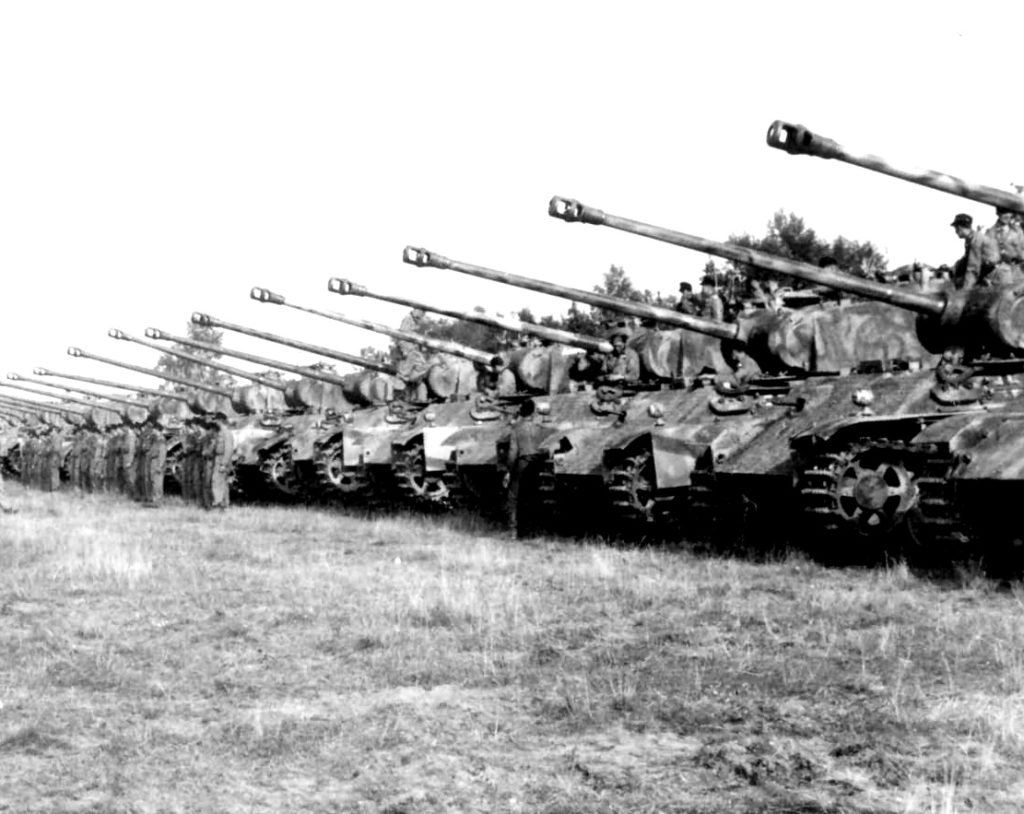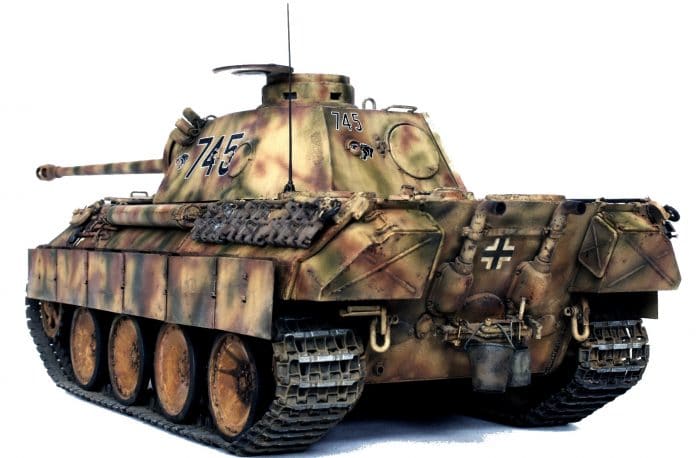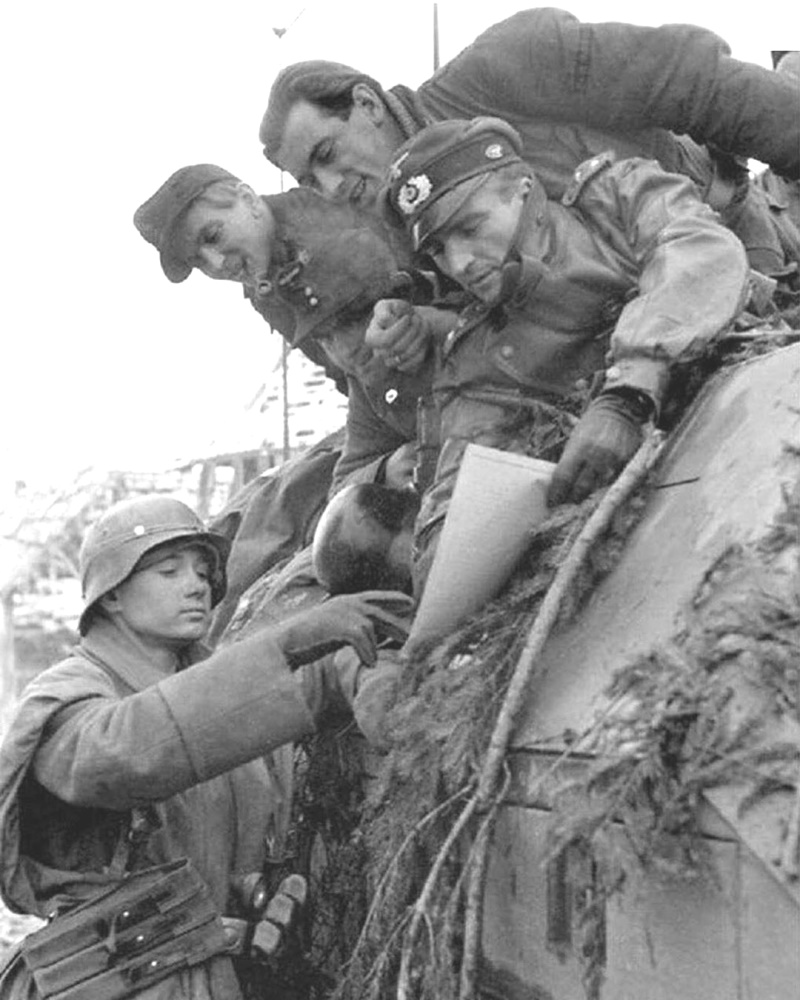THE DEFENSE IS ORGANIZED
At 1200, Dec 17, the situation in the St Vith area was critical. The 14-CG on the north of the 106-ID had been driven back to about a north-south line through St Vith. Their situation was one of confusion and was extremely hazy. To the east of St Vith, the 422-IR and the 423-IR (106-ID) were cut off to the southeast of Schoenberg. Communication with them by radio was sporadic. To the south of St Vith, CCB-9AD was attacking to try to retake Winterspelt (Germany). To its south, the 424-IR (106-ID) was holding the line. To their south, the situation was hazy. There was practically no tie-in of the units mentioned with units on their flanks.
The plan for an immediate attack east from St Vith, to take and hold Schoenberg and open escape corridors for the two surrounded regiments could not be carried out; it was impossible to bring the 7-AD up to the St Vith area over the traffic-congested roads in time to launch the attack that afternoon. CCB-7-AD (Clark) established its command post in a school building in the southeast corner of St Vith; the same building housed the command post of the 106-ID. Staff members of CCB tried to get a relatively accurate picture of the situation from officers of the 106-ID; but it was obvious that the shock of the initial German blow, together with their lack of combat experience, had partially disrupted the staff functioning of the 106-ID. All kinds of rumors were being spread; men who had fled from the front, apparently seeking to justify their action, gave an exaggerated and inaccurate picture of what was taking place. The situation most certainly was bad, and the impression that officers of CCB got was that the 106-ID no longer existed as an effective division.
As the staff sections of CCB began to arrive carrying their equipment into the building, they met men from the 106-ID HQs leaving with their equipment. The defense of the St Vith sector was turned over to Gen Clark by Gen Allan W. Jones the CG of the 106-ID at about 1430, Dec 17, and was largely in his hands for the remainder of the action. At the time of the transfer, the enemy was only about three or four thousand yards from the town, and small-arms fire from the east was coming into the vicinity of the command post. The troops from the 106-ID, which came under Gen Clarke’s command, were: HQs Co, 81st Engineer Combat Battalion, Lt Col T. J. Riggs; HQs Co, 168th Engineer Combat Battalion, Lt Col W. L. Nungesset; 1st Platoon, Fox Co, 423-IR (106-ID CP guard) and the 275th Armored Field Artillery Battalion (S)(105-MM).
This artillery battalion, the 275-AFAB (Separate) assigned to VIII Corps and in position near Ober Emmels (Belgium). They had remained in place despite the fact that no friendly troops were between them and the enemy. They had shifted their batteries so as to form roadblocks and had sited their guns for direct fire. When the 7-AD began to arrive at St Vith, the commanding officer of the 275-AFAB, Col Clay, offered his battalion’s services to Gen Clarke and this unit provided the entire artillery support for the initial defense until the organic artillery of the 7-AD could be brought up into position. The infantry platoon and the engineer elements were sent to the east of St Vith with instructions to proceed until they met Germans and then to dig in and hold. These troops furnished the only resistance to the German advance on St Vith until the arrival of 7-AD units.
The build-up of a defensive cordon around the town was a piecemeal procedure, units being placed in the line as they arrived. Troop B of the 87-CRS was the first unit to arrive. This troop was placed in position on the left of the roadblock established by the troops from the 106-ID. Other troops from CCB were added to the right and left as they arrived until a defensive line was formed east and north of St Vith.
On the 17, Troop B dismounted and went into the center of the line with 6 officers and 136 men. On the 23, this troop had a strength of 47 enlisted men and no officers; casualties included the troop commander, Capt Robert J. Stewart, who was killed. The 87-CRS (minus Troop B) was sent to the northeast of St Vith in the Wallerode area to contact the 14-CG and to protect and screen the left flank. The next unit to arrive was the 38th Armored Infantry Battalion, less one company. It was put to the east of St Vith, and Col William H. G. Fuller, 38-AIB, was given command of that sector, including elements of the 106-ID in place. He was also given Troop B of the 87-CRS, and later, on that evening, was reinforced with Baker Co of the 23rd Armored Infantry Battalion and Able Co of the 31st Tank Battalion. The remainder of CCB (31-TB (-), 23-AIB (-), Baker Co 33-AEB) closed in the assembly area to the west of St Vith.
The build-up of the defense was a piecemeal procedure. At about 1530, elements of HQs Co 81st Engineer Combat Battalion (Lt Col T.J. Riggs); elements of the 168th Engineer Combat Battalion (Lt Col Nungesser), and one platoon of infantry (Fox Co 1/423-IR) established a roadblock east of St Vith. Troop B 87th Cav Recon Sq (Capt Robert J. Stewart) was placed to the north of this roadblock. At about 1630, Baker Co 23rd Armored Infantry Battalion (Capt D. J. Britton) was placed south of the roadblock. Able Co 31st Tank Battalion (Capt R.C. Foster) was also placed south of the roadblock. Able Co 38th Armored Infantry Battalion (Capt W.H. Antsey) was placed north of Troop B 87-CRS and all troops to the east of St Vith were attached to the 38-AIB (Lt Col W.H. Fuller). Troops of the 87-CRS were sent to the north to secure that flank. Other CCB units closed in assembly areas west of St Vith before midnight.
At 0200, the Germans launched the first of the bitter attacks which were to be hurled at the 7-AD during the next six days. The attack hit Reserve Command (CCR) to the north of St Vith and seemed to be a drive to take Recht. Germans of the 1.SS-PD (LSSAH) struck with such force in this night attack that withdrawal of Reserve Command Headquarters to Poteau was ordered. The Germans made effective use of flares shot from their tanks to silhouette out tanks and blind our gunners. The 17-TB (plus Charlie Co, 38-AIB) (Lt Col John P. Wemple), took up positions south of Recht where they could place commanding fire on the town and could assist in covering the north flank of CCB, which was now seriously threatened.
Stopped by Reserve Command, the Germans continued their squeeze play on the St Vith area during the cold, misty morning when at 0800 they hit CCB with a well-coordinated attack by infantry supported by heavy tanks. From the north, the attack moved in on Hünningen and from the east against the line across the Schoenberg road. Hünningen was lost temporarily, but an aggressive counter-attack was mounted by CCB, using three medium tank companies and one tank destroyer company (Baker 31-TB; plus two medium tank companies from the 14-TB; Able 811-TDB, borrowed from CCB-9-AD). The crossroad was recaptured at a cost to the Germans of seven tanks and one armored car destroyed, and over 100 infantry killed. On the east, CCB restored the line with a counter-attack by two medium tank companies (Able and Charlie 31-TB) after initial penetrations had been made. Such counter-attacks, carried out by CCB with aggressiveness and determination, were characteristic of the defense of St Vith and must have caused the Germans to think the defenders were in greater strength than was the case.
While the northern and eastern flanks had been heavily engaged, the northeastern sector (Troop A, 87-CRS; Able 38-AIB; Troop B, 87-CRS) had been rather quiet. The only excitement there had been when an M-8 armored car from Troop B destroyed a German Mark V Panther tank. The armored car had been in a concealed position near the boundary of Troop B, 87-CRS, and Able 38-AIB when the Panther approached the line at right angles to move along a trail in front of the MLR. As the tank passed the armored car, the latter slipped out of position and started up the trail behind the Panther, accelerating in an attempt to close. At the same moment, the German tank commander saw the M-8 and started traversing his gun to beat it. It was a race between the Americans, who were attempting to close so that their 37-MM gun would be effective on the Panther’s thin rear armor, and the Germans, who were desperately striving to bring their 75-MM to beat. Rapidly the M-8 closed to 25 yards, and quickly pumped in thee rounds; the lumbering Panther stopped and shuddered; there was a muffled explosion, followed by flames which billowed out of the turret and engine ports, after which the armored car returned to its position. This action was reported to Maj Donald P. Boyer, S-3, 38-AIB, by Capt W. H. Anstey (CO Able 38-AIB) who witnessed the engagement but misidentified the German Mark V Panther Tank as a Mark VI-2 Tiger. (Doc Snafu)
At about 1000, during the fighting on the north and east flanks, the 31-TB received the disturbing news that its trains, together with those of the 23-AIB, were separated from the rest of the battalion, and fighting a desperate action against strong combat patrols pushing west from Poteau. The two service companies had spent the night near Petit-Thier and were preparing to move up and join their battalions when they were attacked. Using cooks, mechanics, clerks, and a few casuals as infantry, and three tanks, which had just been repaired, the trains successfully disengaged and moved to the rear, then south, and finally into position at Krombach, about four miles southwest of St Vith.
This information indicated that the same tank and infantry forces, which had forced CCR and its 17-TB out of Recht during the early morning, hours, had pushed on to the southwest, had taken Poteau, and were in danger of isolating CCB from the rest of the division. To counter this threat, Dog Co 31-TB was placed astride the St Vith-Poteau road about 1000 yards west of Rodt. Meanwhile, the division ordered CCA to move from Beho, where it was in reserve, and attack to the north and retake Poteau. The Germans recognized well the value of the crossroads at Poteau and intended to hold it at all costs. Immediately after occupying it, they started digging in their tanks and infantry along the woods to the north and east overlooking the crossroads and the open ground surrounding it.
In its initial attack at 1320, CCA forced its way into Poteau, but the murderous fire of the enemy forced them back to cover south of the crossroads. Later, CCA received new orders from the division: Imperative you seize Poteau this PM and hold it!
Just as dark fell, CCA launched its second attack and this time secured the crossroads. It was bitter fighting in the dark; house-to-house fighting by the infantry, and a stand to the last man by the Germans. The stand put up by elements of the 1.SS-PD (LSSAH) which had seized Poteau was an excellent index of the caliber of troops involved in the St Vith operation. Vigorous, well-trained, in splendid physical condition, superbly equipped, and imbued with the idea that nothing could stop them, these SS veterans displayed initiative and skill that stamped them as being the equal of the best troops Germany had employed at any time since 1939.
By noon, it was apparent that although von Rundstedt had not gained St Vith in his first drive, he was determined to take the town through St Vith ran the only east-west railroad between the Rhine River and the Ardennes, and it was learned later that the entire counter-offensive was based upon utilizing the town as the advance rail depot for both, Manteuffel’s 5.Panzer-Army and Dietrich 6.Panzer-Army. Also, the network of roads was needed for deploying the advancing columns of the 5.Panzer-Army towards the northwest so as to support the 9.SS-Panzer in its drive toward Liège and Anvers. Having failed in their initial attempts to take the city, armored spearheads were sliding by on the north and south and preparing to cut into the rear, isolating the 7-AD just as they were to do to Bastogne and the 101-A/B, several days later.




















